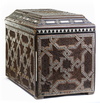A MAGNIFICENT MERINID-STYLE CASKET, MOROCCO, EARLY 20TH CENTURY
The stellar wood panels carved with intricate knot work bordered with micro mosaic strap work, the hinged lid panel with octagonal micro mosaic roundels. 42 by 57.2 by 33.7 cm.
This large chest is made from exquisitely carved cedar wood panels that were originally intended for the Merinid pulpit (minbar) of the Bu ’Inaniya madrasa in Fez. The Bu ’Inaniya madrasa was a religious school founded by Abu ‘Inan (r. 1348-58) and is one of the celebrated jewels of Merinid architecture.
Wooden minbars were often the product of royal commissions, destined to adorn the most prestigious mosques and religious institutions. An example is given in Palestine by the Ayyubid minbar commissioned by Nur al-Din Zengi for the Masjid al -Aqsa in Jerusalem in 1169-74. Considered a masterpiece of Islamic art, it is on par with three celebrated minbars in Morocco, that of the Andalusian Mosque in Fez, dated 980, that of the Kutubiyya mosque in Marrakech, begun in 1137 and that of the Qarawiyyin Mosque in Fez, dated 1144. The Minbar of the Bu ’Inaniya now in the Dar Batha museum makes no exception; it is an extraordinary artwork, a sumptuous example of Islamic decoration. It was commissioned between 1350 and 1355 and draws on the earlier Almoravid tradition as illustrated by the Kutubiyya minbar. It is very close to the Almohad pulpit but details in the decoration such as the presence of pinecones are characteristic of the Merinid style of the period.
The minbar of the Bu ’Inaniya mosque was so highly esteemed by the inhabitants of Old Fez that they opposed its transfer to the Dar Batha Museum in 1937. The minbar stayed a few days at the museum before being returned to the madrasa under the pressure of the inhabitant. The minbar eventually entered the collection of the Dar Batha Museum in 1966. The panels that were made for its restoration at the time (until today, the pulpit has many losses) were never set on the minbar but were assembled as a chest, which is the present box.
Published in: Maroc Médiéval, Un empire de l’Afrique a l’Espagne, Lintz, 2014, fig. 2, p. 53.
Please note: this lot contains ivory and is therefore subject to the relevant trade restrictions in correspondence with CITES regulations. Customers should familiarize themselves with the relevant CITES regulations before bidding.







